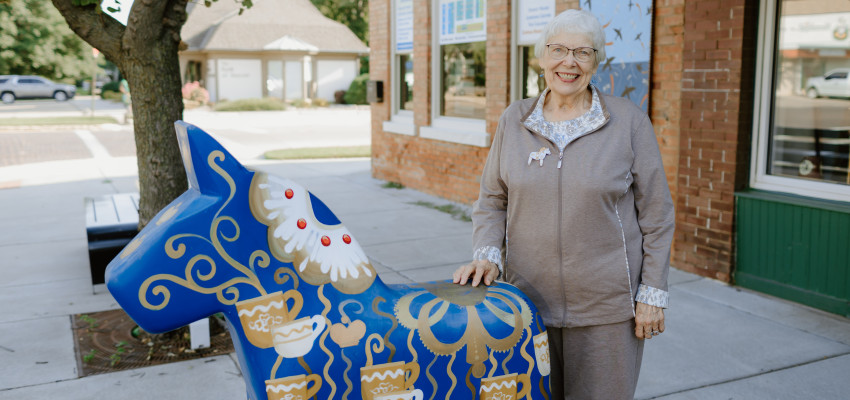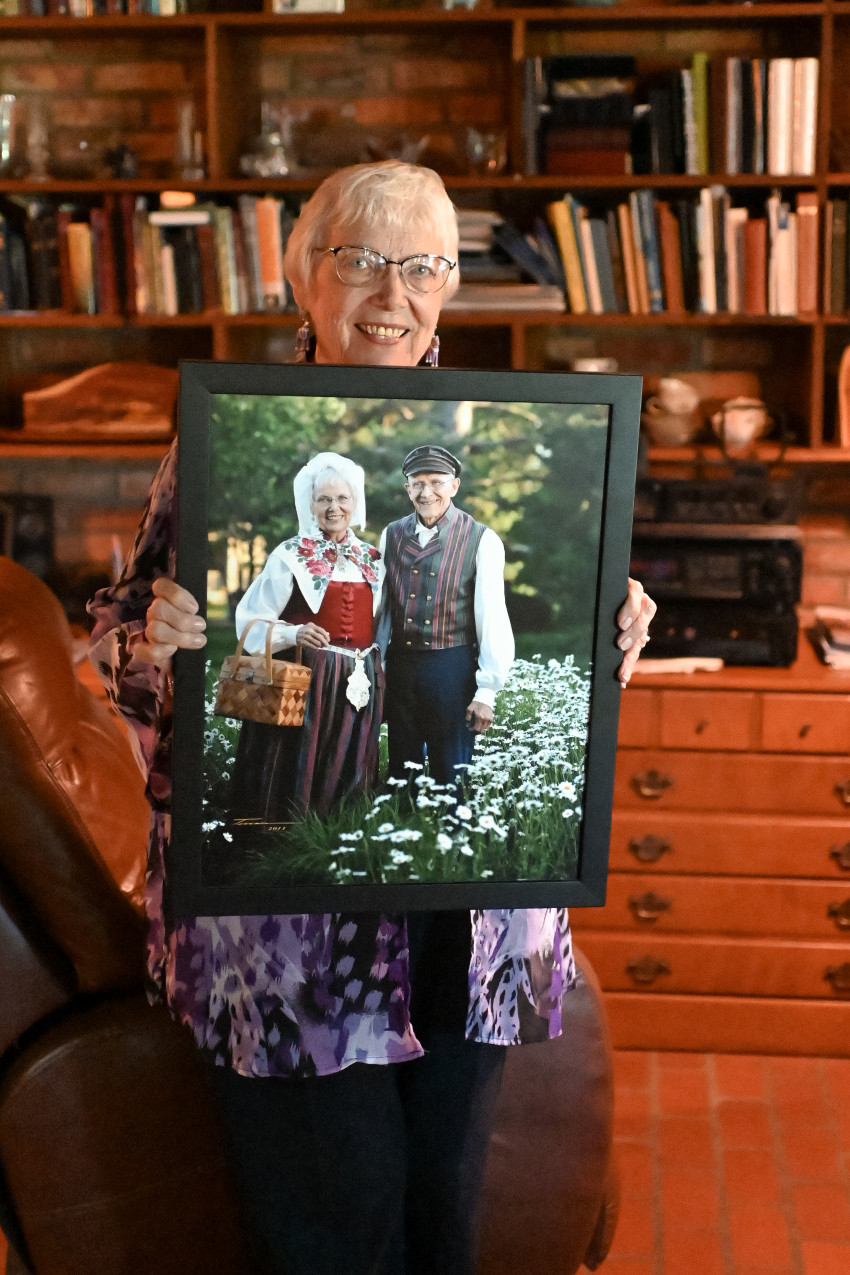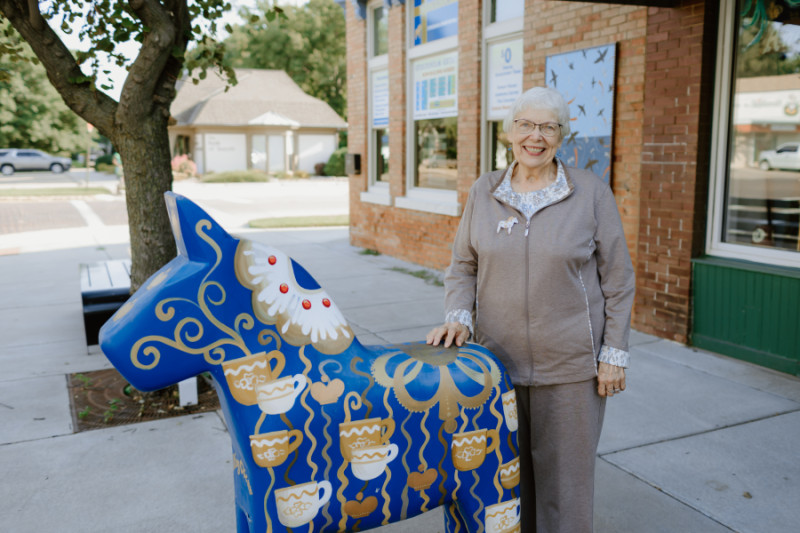By Sheridan Wimmer on November 6, 2023
Explore a Swedish Kansas town that celebrates its culture

Whether you enjoy or despise Hallmark movies, they have perfected the formula of a feel-good holiday plot. A girl moves to a small town to save it from some sort of ruin, meets a local blue-collar worker, they banter and eventually, the town is saved and they fall in love.
No matter your reaction — whether it’s “aww” or “ugh” — Lindsborg (BORG, not berg) was named the “Most Hallmark Movie-esque Small Town” in 2021 by Travel Awaits, and that makes us want to grab a hot chocolate and a blanket as we explore its charms.
LITTLE SWEDEN
Lindsborg is a community of 3,800 in McPherson County just off Interstate 135. Not only does it feel like a Hallmark movie, but it also has a rich history of Swedish culture and tradition with a European ambience. Lindsborg is known as “Little Sweden” because of its history as a settlement founded by Swedish immigrants.
In the 1830s and ’40s, Sweden’s population was growing. For a place that was rooted in agriculture, the population growth pushed Swedish farmers to immigrate to America in search of land. According to the Library of Congress, between 1861 and 1881, 150,000 Swedes set off for the United States. Many made their way to Chicago. In 1900, Chicago was considered the second-largest Swedish city in the world.
From Chicago, settlers from the Värmland province of Sweden formed the First Swedish Agricultural Company of McPherson County in 1868, and they sent agents to Kansas to purchase land. The name Lindsborg comes from three men who held prominent positions in the Agricultural Company: Lind, Lindgen and Lindahl.
Ruth Peterson is originally from a small town north of Lindsborg called Smolan, which is where her grandfather immigrated to from Sweden as a teenager, and has lived in or near Lindsborg for more than 80 years. She is rich in her knowledge of Swedish culture and stories.
“The Swedes in Chicago bought thousands of acres out here for homesteading,” she says. “I have a painting by my front door of what was called bolagshuset (BO-logs-HU-set), which means company house, and it was the location where I grew up. Immigrants would go to that company house to figure out where their farm ground would be. When they built the railroad, they established the town here.
“My grandfather came and married a Swede here and became a progressive farmer — at least in those days, he was progressive,” she says. “He built a beautiful house and barn just to the west of Smolan. It had indoor plumbing and electricity, which nobody else did at that time since it was the ’20s.”
WHEAT FIELDS TO BATTLEGROUNDS
Late 1939 to 1945 brought a significant event in world history. World War II required a substantial military effort that made its way into the heart of Kansas.
“The government came in during World War II and built an army base out here,” Peterson says. “They bought thousands of acres to build it, and that meant the farms would be destroyed, including the little house we were living in. Some families had only days to leave their homes and farms.”
In 1942, hundreds of farm families left their wheat crop in the field so the U.S. Army installation could be built. The post, Camp Phillips, brought in construction equipment as workers burned wheat fields.
“My dad for years would look at his wheat after this happened and say, ‘Not as good as it was in 1942,’” Peterson remembers. “It was this gorgeous crop, but it was all burned for the base. Farmers were paid minimally for their land, but it was the war effort.”
The experience for Peterson was difficult, and she recalls having to return to the house when they moved out.
“We and so many other families had to move farm machinery, animals, household items — the whole bit,” she says. “I have one memory of going back to the house to get the last few items. Although my parents were very good about talking about what was happening in a way that wouldn’t scare us kids, I overheard them talking about the burning. When we went to the house, I thought they’d burn it while we were there.”
Although the house she began her childhood in wasn’t spared, Peterson’s grandfather’s house became the emergency hospital and officers’ headquarters since it already had plumbing and electricity.
“That house is still there, and it’s still lovely,” she says.
When the war ended, the government offered the land back to the farmers, but many had already settled in new locations, and Lindsborg was home for Peterson.
“By then we were settled here, and we were in school,” she says.
HALLMARK ROMANCE
Ruth married Walden Peterson in October 1958 after a courtship Hallmark could only dream of.
“Walden was in dental school in Kansas City, and when I finished high school, I went to school in Chicago,” she says. “One summer, there was a camp retreat for college-aged and young adults with our church group. That’s where we met.”
Walden’s friend — the ultimate wingman — set up the couple. Afterward, the two went back to their respective cities and began corresponding through letters until a spring choir event took Walden to Chicago.
“Our choir had a big fancy banquet at the end of the year,” Peterson says. “He wanted to come, and I said that would be great! When he was here, he was so fidgety and kept checking his shirt pocket. I thought, ‘What is wrong with this man?’”
Walden turned out to have a diamond in his shirt pocket.
Walden graduated in June from dental school and in October, the couple was married. They had three sons — Mark, Ralph and Dale — but were met with heartbreak when their youngest, Dale, died unexpectedly in his sleep in 2015. After 47 years as a dentist in Lindsborg, Walden retired. Walden passed away in 2021.
“I’m thankful for my deep faith and trust in God,” Peterson says. “I was blessed with a beautiful family with lots of joy, and I hold onto that.”
SWEDISH TRADITIONS
Some of that joy came in the form of the many Swedish traditions her family honored, including speaking Swedish.
“When I was growing up, my parents would speak in Swedish when they didn’t want us to know what they were saying,” Peterson jokes. “They taught me some songs, but I didn’t speak Swedish as fluently as they did until later in life.”
A tradition celebrated by Swedish cultures — including the town of Lindsborg — is the Festival of St. Lucia (Loo-SEE-uh). Traditionally, the day is celebrated on Dec. 13, but in Lindsborg, it’s usually observed the Saturday closest to that date. This year, the festival will be celebrated Dec. 9.
The legend of St. Lucia is that a woman named Lucia, meaning “light,” prayed that if her ill mother could be healed, she would remain unmarried and devote her life to God. When Lucia’s mother was healed, Lucia received her mother’s inheritance and gave it to the poor. The man who was interested in marrying Lucia was upset about losing both her and the inheritance and reported her to the government as a witch. She was killed at age 20 and remains a martyr. After her death, a ship carrying a woman “clothed in white and crowned with light” appeared on the Swedish shoreline during a famine and distributed food and clothing.
Lindsborg’s St. Lucia festival celebration includes performances by its Swedish Folk Dancers, a group of high school students who are dedicated to promoting the study and appreciation of traditional Swedish folk dance. The town also has a church service to honor St. Lucia at which Swedish ginger cookies are served. Peterson celebrates St. Lucia in her own way.
“Because of my heritage and knowing the stories of Swedish folklore, we kept some traditions,” Peterson says. “Some families, because they wanted to be Americans when they immigrated here, didn’t keep the traditions. While I didn’t celebrate St. Lucia when I was young, I fell in love with the tradition when I learned about it.”
The traditional celebration entails the oldest daughter in the family waking up early, putting on a white robe and crown with lights and taking breakfast in bed to her family.
“So I started to dress up and honor the tradition in my own family,” Peterson says. “When my sons moved away from home, I would take food to neighbors or friends with my white robe and crown. I’ve done it every year for more than 30 years now.”
What’s even more special about St. Lucia for Peterson is she’s continued the celebration with her kids and grandkids.
“The favorite thing for me is that my sons all celebrate Lucia with their own families,” she says. “I’m so pleased they do that.”
Another Lindsborg event called Svensk Hyllningsfest, or Swedish Honoring Festival, celebrates the community’s Swedish heritage and includes folk dancing performances, arts and crafts, an authentic smörgåsbord and more. In 2011, Walden and Ruth were honored by being named the Svensk Hyllningsfest king and queen.
“Whomever is nominated has to have some Swedish heritage, be involved in the community and want to keep some of the traditions,” she says. “It was quite an honor.”
Holly Lofton, director of Lindsborg’s Convention and Visitors Bureau, says Peterson is a great community member and representative of Swedish culture.
“Ruth goes to church with us. That’s how I first met her,” Lofton says. “She is known for being the greeter and makes sure she meets anybody who’s new in town. She’s incredibly hospitable, and she has a rich history of Swedish culture and heritage.”
You’ll find many Christmas celebrations to enjoy in Lindsborg. Browse the calendar of events at www.visitlindsborg.com/christmas-in-lindsborg.
VISIT LINDSBORG
Lindsborg has a lot to offer its visitors, both at Christmastime and throughout the year.
Peterson, who has traveled to Sweden twice, enjoys collecting Dala horses, traditional Swedish toys in the shape of tailless horses made of wood. The toys originated in the in the province Dalarna in central Sweden. Today, Dala horses can be seen throughout Lindsborg as public art decorated in various schemes and on many homes.
“It became popular to have a Dala horse made with your last name on it, and you’d put it on your door or entryway to your home,” Peterson says. “Then when Hemslöjd, our store downtown, which translates to ‘homemade’ or ‘home store’ opened, they started making the Dala horse as Lindsborg’s symbol. Now the horse is on everything, from the police cars to the ambulance to the flags.”
The Herd of Wild Dala Horses is a fun feature of Lindsborg. A group of more than 35 Dala horse sculptures are scattered throughout town and feature different artistic touches showcasing the town’s cultural heritage, education, arts community, agriculture and more.
Lindsborg draws visitors — and potential residents — through its unique attractions and family-friendly atmosphere.
“It’s an unusual spot and the only Lindsborg in the world,” Lofton says. “My family moved here because we visited here, so I think about that when I do my job. It’s a safe place to be with wonderful arts programming and great schools. We love our life here; there’s always something wonderful going on.”
Lofton says the town has grown 8.3 percent since the previous census, which is something small towns don’t often achieve. With the rich history, arts culture (National Geographic photographer Jim Richardson lives in Lindsborg) and community pride, more people are looking for a place like Lindsborg.
“We have a new state-of-the-art childcare location we just opened and a new housing development that’s already full, and the town is looking to build more,” Lofton says. “I hope we can be an example to other small towns that they too can thrive.”
Although Lindsborg is Hallmark movie-esque, it doesn’t need help being saved from any type of ruin. After all, it’s got Ruth Peterson.






